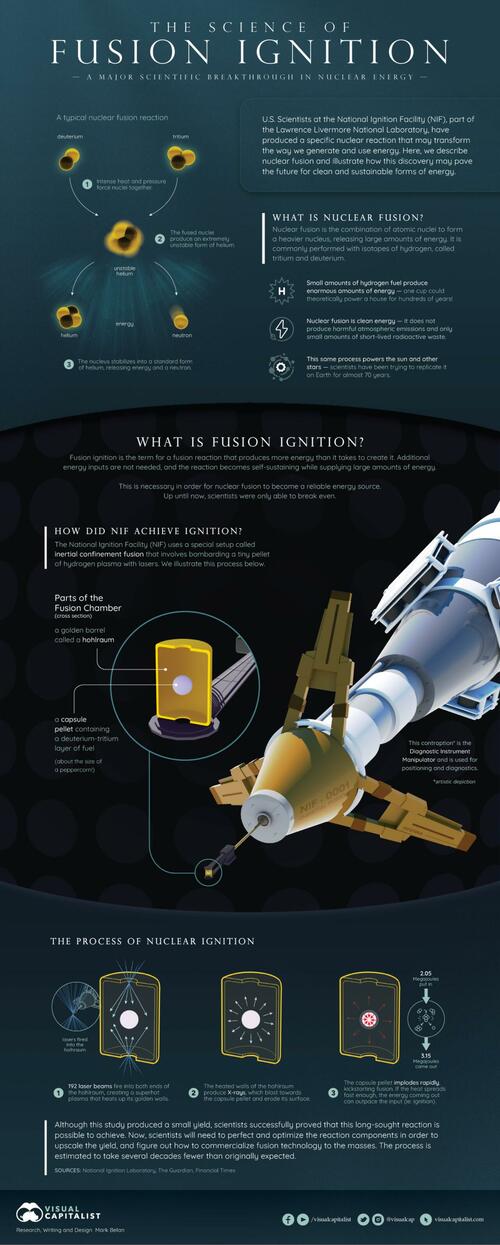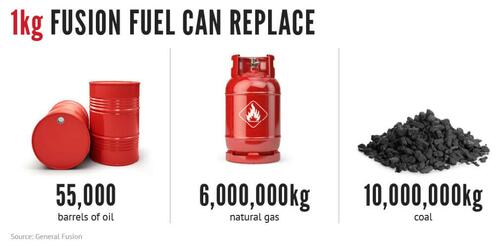
U.S. scientists at the National Ignition Facility, part of the Lawrence Livermore National Laboratory (LLNL), announced a major breakthrough in nuclear fusion this week.
For the first time ever, scientists successfully produced more energy from a nuclear fusion experiment than the laser energy used to power it.
In the infographic below, Visual Capitalist's Mark Belan and Bruno Venditti describe nuclear fusion and illustrate how this discovery may pave the future for a new form of clean and sustainable energy.
What is Nuclear Fusion?
Nuclear fusion powers the Sun and the stars, where immense forces compress and heat hydrogen plasma to about 100 million degrees Celsius. At this temperature, the lighter particles fuse into helium, releasing enormous amounts of energy.
Nuclear fusion is a fairly clean energy source as it does not produce harmful atmospheric emissions and only produces a small amount of short-lived radioactive waste.
Scientists have been trying to replicate it on Earth for almost 70 years, using isotopes of hydrogen—deuterium and tritium—to power fusion plants.
Since deuterium is found in seawater and tritium is attained through irradiating lithium (a common element used in batteries), the accessibility of these isotopes means that fusion could become a major source of energy in the future.
The amount of deuterium present in one liter of water, for example, could produce as much fusion energy as the combustion of 300 liters of oil.
However, the real challenge is ensuring fusion power plants generate more energy than they consume.
The Challenge of Fusion Ignition
Fusion ignition is the term for a fusion reaction that becomes self-sustaining, in which the reaction creates more energy than it uses up. Up until now, scientists were only able to break even.
The National Ignition Facility used a special setup called inertial confinement fusion that involves bombarding a tiny pellet of hydrogen plasma with lasers to achieve fusion ignition.
LLNL’s experiment surpassed the fusion threshold by delivering 2.05 megajoules (MJ) of energy to the target, resulting in 3.15 MJ of fusion energy output, according to the U.S. Department of Energy.
Can Nuclear Fusion Energy Be Commercialized Soon?
In recent years, fusion technology has been attracting the attention of governments as well as private companies such as Chevron and Google. Bloomberg Intelligence estimates that the fusion market will eventually be worth $40 trillion.
Besides energy generation, fusion is expected to be used in other markets like space propulsion, marine propulsion, and medical and industrial heat.
However, according to the director of the Lawrence Livermore National Laboratory, Kim Budil, it will take “probably decades” before nuclear fusion energy is commercialized.
During the breakthrough announcement, she noted that it was necessary to produce “many many fusion ignition events per minute” as well as have a “robust system of drivers” before fusion can be commercialized successfully.
U.S. scientists at the National Ignition Facility, part of the Lawrence Livermore National Laboratory (LLNL), announced a major breakthrough in nuclear fusion this week.
For the first time ever, scientists successfully produced more energy from a nuclear fusion experiment than the laser energy used to power it.
In the infographic below, Visual Capitalist’s Mark Belan and Bruno Venditti describe nuclear fusion and illustrate how this discovery may pave the future for a new form of clean and sustainable energy.
What is Nuclear Fusion?
Nuclear fusion powers the Sun and the stars, where immense forces compress and heat hydrogen plasma to about 100 million degrees Celsius. At this temperature, the lighter particles fuse into helium, releasing enormous amounts of energy.
Nuclear fusion is a fairly clean energy source as it does not produce harmful atmospheric emissions and only produces a small amount of short-lived radioactive waste.
Scientists have been trying to replicate it on Earth for almost 70 years, using isotopes of hydrogen—deuterium and tritium—to power fusion plants.
Since deuterium is found in seawater and tritium is attained through irradiating lithium (a common element used in batteries), the accessibility of these isotopes means that fusion could become a major source of energy in the future.
The amount of deuterium present in one liter of water, for example, could produce as much fusion energy as the combustion of 300 liters of oil.
However, the real challenge is ensuring fusion power plants generate more energy than they consume.
The Challenge of Fusion Ignition
Fusion ignition is the term for a fusion reaction that becomes self-sustaining, in which the reaction creates more energy than it uses up. Up until now, scientists were only able to break even.
The National Ignition Facility used a special setup called inertial confinement fusion that involves bombarding a tiny pellet of hydrogen plasma with lasers to achieve fusion ignition.
LLNL’s experiment surpassed the fusion threshold by delivering 2.05 megajoules (MJ) of energy to the target, resulting in 3.15 MJ of fusion energy output, according to the U.S. Department of Energy.
Can Nuclear Fusion Energy Be Commercialized Soon?
In recent years, fusion technology has been attracting the attention of governments as well as private companies such as Chevron and Google. Bloomberg Intelligence estimates that the fusion market will eventually be worth $40 trillion.
Besides energy generation, fusion is expected to be used in other markets like space propulsion, marine propulsion, and medical and industrial heat.
However, according to the director of the Lawrence Livermore National Laboratory, Kim Budil, it will take “probably decades” before nuclear fusion energy is commercialized.
During the breakthrough announcement, she noted that it was necessary to produce “many many fusion ignition events per minute” as well as have a “robust system of drivers” before fusion can be commercialized successfully.
Loading…






